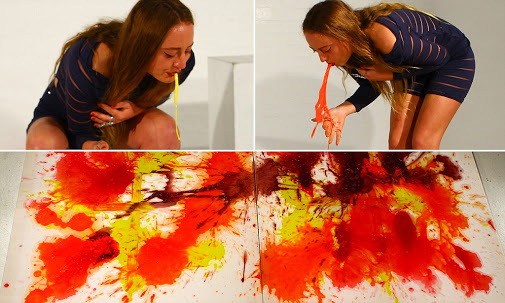I wrote this piece 15 years ago — my explanation of how two lines of development of modern art culminated in postmodernism. (Translations via here into German, Spanish, Korean, and Portuguese).
Now I feel the need to write a follow-up: Why Art is Still Ugly.
Related:
* Taking Modern Artists at Their Word. September 2014. Translation into Portuguese.
* The Most Important Artist of the Century. Guess who? December 2014. Translation into Portuguese.
* Does Martin Creed Speak for All of Us? June 2016. On Creed’s 2016 retrospective at New York’s Armory, and what the sad-sack irritant’s significance is for the contemporary art world.
* The feature image above is from Millie Brown’s contribution to postmodernism.

I’m a bit of a heretic in this: I think that part of the explanation is that there has always been a place for art in which the intended audience is other artists. For example, I recall in college listening to a musical piece while visiting a friend. It did nothing for me–sounded like little more than noise–but he, being a sax player, found it deeply entertaining. It was incredibly difficult from a technical perspective, and as a fellow musician he could appreciate it on a level that was closed off to me, as a non-musician. I’ve seen similar pieces in painting, sculpture, jewelry, and other art forms, stretching back for centuries.
In a sane world, these would be a small subset of any art field. The audience is limited, after all–it’s nothing more (and nothing less) than showing off for your peers. My friend didn’t expect me to enjoy the music we listened to, nor did he lecture me on needing to “educate my pallet” or whatever nonsense the postmodernists prattle on about–I wasn’t the audience, and no one expected me to be the audience. There was no shame in it, just as there is no shame in my musician friend not getting geology jokes.
I think postmodernism took this legitimate concept and distorted it. It’s this showing off that allowed postmodernism to pretend that there was legitimacy to what they were doing, and which served as a smoke-screen to hide the vapidity of their “art”. Quite obviously postmodern art ISN’T highly skilled people doing incredibly difficult things for the sake of showing to other experts how skilled they are, but we the public allowed them to pretend that they were. And it allowed postmodernists to club to death real art, by pretending that real art doesn’t require high levels of skill because it’s not for the “elite”. (The reality, of course, is the opposite–popular art has always required a high degree of technical skill, in ALL areas, while pieces intended to show off only demonstrate skill in one, maybe two, areas.)
So in a way, I can see where those who fall for postmodernism’s nonsense are coming from. They are confusing it for a legitimate, though very limited, concept. They aren’t innocent, though: they allow themselves to be duped–they grant their moral sanction to the frauds that perpetuate non-art–because they’re too cowardly to say “I’m not an expert in this field, and am not the intended audience.” Their desire to appear to be among the elite forbids them from admitting that the emperor has no cloths, and their desire to not let themselves find out that they’ve been had causes them to viciously attack anyone with the audacity to say that he’s naked.